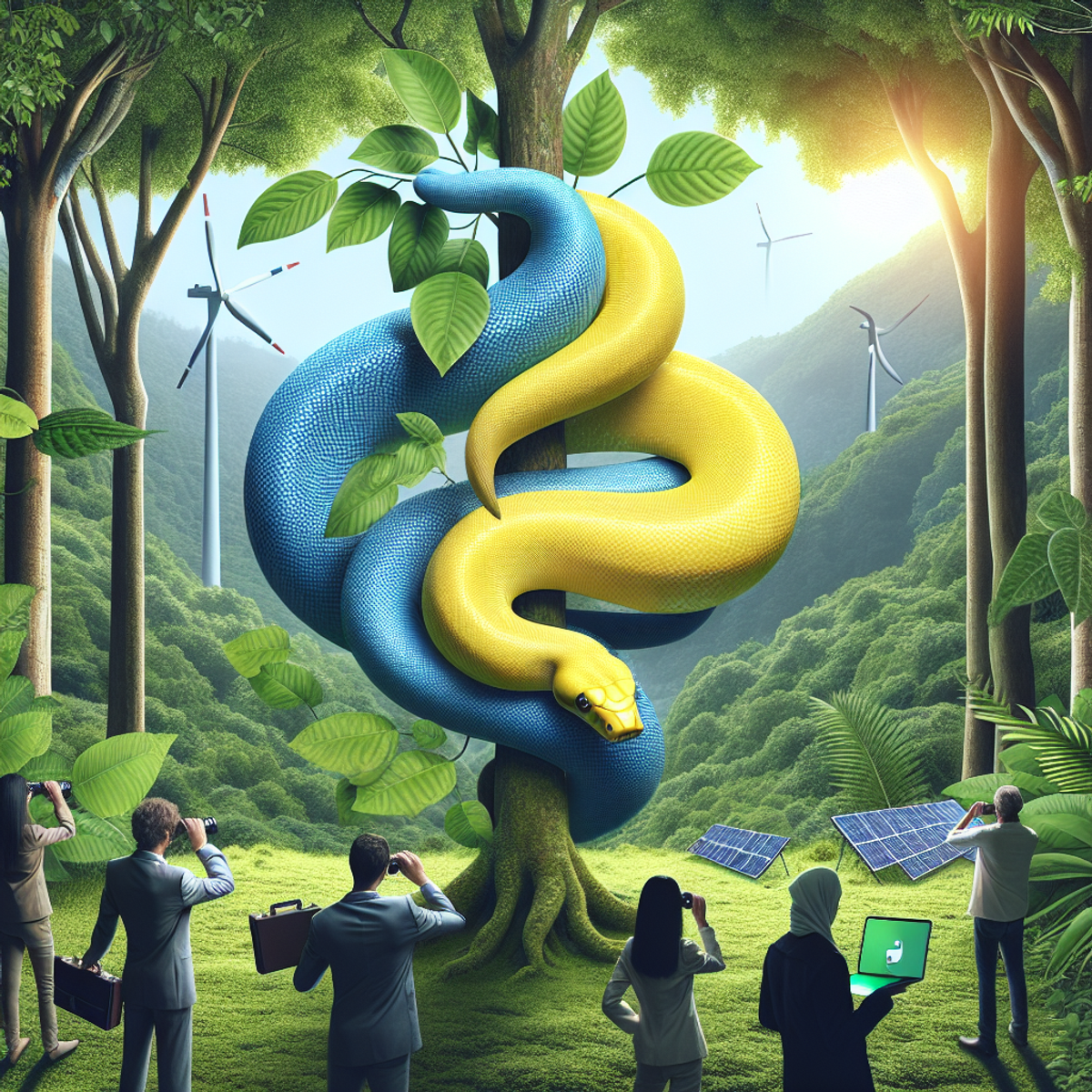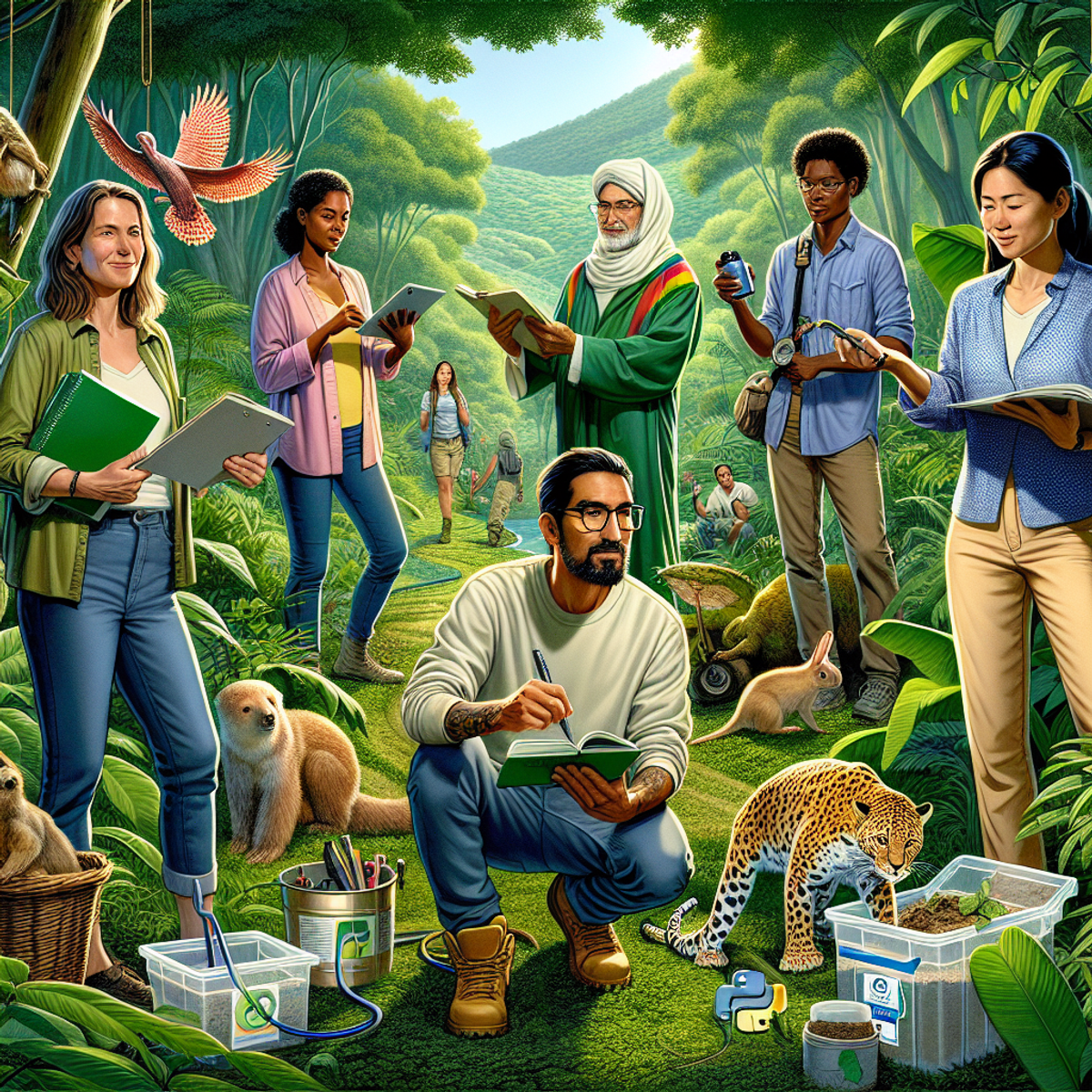Python and Eco-Tourism: Conservation Awareness

Python and Eco-Tourism: Conservation Awareness
Introduction
Python, Eco-Tourism, Conservation Awareness
The world is experiencing an increasing need for sustainable practices and conservation efforts. As our society becomes more aware of the environmental challenges we face, it is essential to find innovative solutions that promote conservation awareness. One powerful tool in this endeavor is Python programming.
Python, a versatile and easy-to-learn programming language, has gained popularity across various industries for its ability to solve complex problems efficiently. When it comes to eco-tourism and conservation awareness, Python can play a significant role in creating impactful solutions.
Eco-tourism, defined as responsible travel to natural areas that conserves the environment and improves the well-being of local communities, has become a vital approach to sustainable tourism. By embracing eco-tourism principles, we can strike a balance between visitor experiences and environmental protection. Python programming offers unique opportunities to enhance conservation education, advocacy, and sustainable tourism management in eco-tourism initiatives.
Through interactive websites, data visualization tools, educational games or apps, Python can amplify conservation education efforts. By harnessing the power of Python, organizations and individuals can create engaging platforms that deliver valuable information about pressing conservation issues. These platforms can help raise public awareness and mobilize support for policy change.
Python's capabilities go beyond education alone. It can also be leveraged to optimize sustainable tourism management. By utilizing remote sensing data and machine learning algorithms, Python-based systems can effectively monitor visitor impact in ecologically sensitive areas. This data-driven approach allows for better resource allocation, minimizing conflicts between conservation and recreational activities while ensuring a high-quality visitor experience.
While Python presents immense potential in promoting conservation awareness through eco-tourism, it is essential to acknowledge the challenges and limitations that may arise. Accessibility issues in remote areas with limited technological infrastructure can hinder the implementation of Python-based solutions. Additionally, interdisciplinary collaboration is crucial to ensure effective interpretation and implementation of data-driven approaches.
Looking ahead, Python continues to evolve as a powerful tool for sustainable visitor engagement. Emerging technologies such as artificial intelligence and virtual reality offer exciting possibilities for creating immersive yet low-impact visitor experiences. Python's versatility and integration capabilities make it well-suited for innovating in this space, fostering a deeper understanding and appreciation of nature while adhering to the principles of eco-tourism.
The relationship between Python programming and eco-tourism is a promising one. This article aims to explore the concept of eco-tourism and its crucial role in conservation efforts. By harnessing the power of Python, we can raise awareness, find sustainable solutions, and contribute to a more inclusive and environmentally conscious tourism industry. Together, let us embrace responsible travel and leverage innovative technologies like Python to drive positive change in how we explore and protect our natural world.
Python and Eco-Tourism: Conservation Awareness
Eco-tourism is crucial for raising conservation awareness and promoting sustainable practices. It's a responsible way of traveling that not only lets people experience the beauty of nature but also highlights the importance of protecting the environment and involving local communities. In this section, we'll explore how Python programming can contribute to conservation awareness in eco-tourism.
1. Understanding Python's Role in Conservation Education and Advocacy
Python programming offers various tools and technologies that can enhance conservation education efforts and support advocacy for environmental issues. Here are some ways Python is being used:
- Interactive websites: Python enables the creation of interactive websites that engage visitors with immersive content and educational resources. For example, organizations can develop web-based platforms where users can explore different ecosystems, learn about endangered species, and understand the impact of human activities on the environment.
- Data visualization: Python's data visualization libraries, such as Matplotlib and Seaborn, allow conservationists to present complex ecological data in a visually appealing and understandable manner. By visualizing data on deforestation rates, wildlife populations, or climate change patterns, Python helps communicate the urgency of conservation issues to a wider audience.
- Educational games or apps: Python is widely used in developing educational games or applications that promote conservation awareness among children and adults alike. These interactive tools provide an engaging way to learn about ecosystems, biodiversity, and sustainable practices. For instance, Python-powered apps may simulate wildlife tracking experiences or encourage users to solve environmental challenges.
Case studies demonstrate the effectiveness of Python programming in raising public awareness about pressing conservation issues. One notable example is the WildCam Gorongosa project, which uses Python-based software to analyze camera trap images from Gorongosa National Park in Mozambique. Through this initiative, citizen scientists can identify animals captured in these images, contributing valuable data for wildlife monitoring and conservation efforts.
2. Leveraging Technology for Sustainable Tourism Management
Python-based systems can play a significant role in sustainable tourism management by effectively monitoring visitor impact in ecologically sensitive areas and optimizing resource allocation. Here are some ways Python contributes to this aspect of eco-tourism:
- Remote sensing data: Python enables the analysis of remote sensing data, such as satellite imagery, to monitor changes in land cover, deforestation rates, and habitat fragmentation. By leveraging Python's capabilities, conservationists can assess the environmental impact of tourism activities and make informed decisions to protect vulnerable ecosystems.
- Machine learning algorithms: Python's machine learning libraries, including scikit-learn and TensorFlow, can help develop algorithms that identify patterns in visitor behavior and predict potential ecological impacts. For instance, these algorithms can analyze visitor density data to determine optimal carrying capacities for ecotourism destinations, ensuring that tourism activities remain sustainable.
Python has also been instrumental in the development of innovative tourism management platforms or solutions. One example is the "SMART Park" system implemented in South Africa's Kruger National Park. This system combines Python programming with geospatial technology to track wildlife movements, detect poaching activities, and manage visitor access effectively while minimizing disturbances to wildlife populations.
Challenges and Limitations in Applying Python to Eco-Tourism Initiatives
While Python programming offers numerous benefits for eco-tourism initiatives, there are also challenges and limitations to consider. These include:
- Accessibility issues: In remote areas with limited technological infrastructure, accessing Python-powered tools or platforms may be challenging. It is crucial to ensure that conservation efforts do not exclude communities or regions lacking sufficient connectivity or technological resources.
- Interdisciplinary collaboration: Effective implementation of data-driven solutions requires interdisciplinary collaboration between conservationists, programmers, and local stakeholders. It is essential to bridge the gap between technical expertise and conservation knowledge to maximize the impact of Python programming in eco-tourism initiatives.
By acknowledging these challenges and limitations, stakeholders can work together to address them and find innovative solutions that leverage Python programming effectively.
Future Directions: Innovating with Python for Sustainable Visitor Engagement
Looking ahead, there are exciting opportunities to further leverage Python and related technologies for sustainable visitor engagement in eco-tourism. Here are some emerging trends:
- Artificial intelligence: Python's integration with artificial intelligence technologies opens doors to immersive, low-impact visitor experiences. Virtual tour guides powered by AI can provide personalized information about ecosystems, wildlife behavior, and conservation challenges, fostering a deeper understanding and appreciation of nature.
- Virtual reality: Python can be combined with virtual reality (VR) technologies to create realistic and immersive virtual environments for eco-tourism. VR experiences allow visitors to explore fragile ecosystems without physically disturbing them, raising awareness about the importance of conservation and promoting responsible travel practices.
These innovations hold great potential for transforming the way we engage with nature while minimizing our ecological footprint. By embracing Python programming and its synergies with emerging technologies, we can continue to drive positive change in the eco-tourism industry.
The Significance of Eco-Tourism in Conservation
Eco-Tourism: What It Means and Why It Matters
Eco-tourism, as defined by Wikipedia, is a form of responsible travel to natural areas that conserves the environment and sustains the well-being of local people. It involves immersing oneself in natural habitats and cultural experiences while promoting conservation and fostering environmental understanding and respect.
Key Aspects of Eco-Tourism
- Conservation Focus: Eco-tourism places a strong emphasis on preserving the natural environment and protecting wildlife.
- Community Involvement: It actively involves local communities in tourism activities, ensuring they benefit economically and socially (source).
- Education and Awareness: Eco-tourism seeks to educate visitors about environmental issues and inspire them to support conservation efforts (source).
The Benefits of Eco-Tourism
1. Positive Impact on Local Communities
Well-managed eco-tourism activities can significantly benefit local communities by providing economic opportunities, fostering cultural exchange, and preserving traditional knowledge and practices. By involving local residents in tourism-related initiatives, eco-tourism contributes to community empowerment and sustainable development.
2. Biodiversity Conservation
Eco-tourism plays a crucial role in preserving biodiversity by providing financial incentives for the conservation of natural habitats and wildlife. Through revenue generated from eco-tourism activities, protected areas can be maintained, wildlife corridors can be established, and critical habitats can be safeguarded from encroachment and degradation.
3. Health of Ecosystems
Sustainable eco-tourism practices help maintain the overall health of ecosystems by promoting responsible behavior among visitors and minimizing disturbances to natural processes. By raising awareness about the value of intact ecosystems, eco-tourism encourages active participation in conservation efforts and fosters a sense of stewardship towards the environment.
"The future will either be green or not at all." - Bob Brown
Eco-tourism not only benefits local communities and protects biodiversity but also offers a unique opportunity for individuals to connect with nature on a deeper level. By experiencing firsthand the beauty and fragility of our planet, we can cultivate a greater appreciation for its wonders and be inspired to take action in preserving it for future generations.
1. Understanding Python's Role in Conservation Education and Advocacy
Introducing Python in Conservation Education
Python programming plays a crucial role in enhancing conservation education efforts by providing innovative tools and platforms to engage and educate the public about pressing environmental issues. Through the use of Python, various interactive websites, data visualization techniques, and educational games or apps can be developed to create an immersive learning experience for individuals interested in conservation awareness.
Interactive Websites
Python enables the creation of dynamic and user-friendly websites that offer valuable information about conservation initiatives, biodiversity hotspots, and environmental challenges. These websites can incorporate interactive maps, multimedia content, and real-time data visualization to make the learning process more engaging and impactful. For example, interactive dashboards powered by Python can display real-time data on wildlife populations, deforestation rates, or climate change indicators, allowing users to explore and understand complex environmental trends with ease.
Data Visualization
Python's libraries such as Matplotlib and Seaborn provide powerful tools for visualizing complex datasets related to conservation and environmental science. By presenting data in visually compelling ways through charts, graphs, and infographics, Python facilitates a deeper understanding of ecological patterns and human impacts on natural systems. This visual storytelling approach not only educates the audience but also fosters empathy and motivation for positive change.
Educational Games or Apps
Python programming is utilized in the development of educational games or apps that simulate real-world conservation scenarios, encouraging active participation and learning. For instance, virtual simulations powered by Python can allow users to experience the challenges of wildlife conservation or habitat restoration efforts firsthand, promoting a sense of responsibility and stewardship towards the environment.
Case Studies: Python in Conservation Advocacy
Numerous case studies demonstrate the impactful application of Python in raising public awareness about critical conservation issues and mobilizing support for policy change. For example:
- Wildlife Tracking: Conservation organizations leverage Python-based platforms to track and monitor endangered species using GPS data. By visualizing animal movements on interactive maps developed with Python libraries like Folium or Plotly, these organizations effectively communicate the urgency of protecting wildlife habitats and minimizing human-wildlife conflicts.
- Policy Analysis: Python is employed to analyze large-scale environmental datasets and assess the effectiveness of conservation policies. Through advanced statistical modeling and machine learning algorithms, Python helps identify trends in ecosystem health, quantify ecological risks, and inform evidence-based policy recommendations aimed at preserving natural resources.
In summary, Python programming serves as a versatile tool for advancing conservation education efforts through interactive technologies and fostering advocacy for sustainable environmental policies. Its ability to translate complex scientific data into accessible formats empowers individuals to become informed advocates for biodiversity preservation and habitat protection.
2. Leveraging Technology for Sustainable Tourism Management
Python programming is not only valuable for conservation education and advocacy but also plays a crucial role in sustainable tourism management. By leveraging Python-based systems, we can enhance the monitoring of visitor impact in ecologically sensitive areas and ensure the long-term sustainability of tourist activities. Here are some key points to consider:
Effective monitoring of visitor impact
Python-based systems enable more efficient and accurate monitoring of visitor activities in ecologically sensitive areas. Through the use of remote sensing data and machine learning algorithms, Python can help analyze and interpret data collected from various sources such as satellite imagery, drones, and on-site sensors. This allows for a comprehensive understanding of visitor behavior, including factors like footfall patterns, habitat disturbance, and wildlife interactions.
Innovative tourism management platforms
Python-powered solutions have been developed to optimize resource allocation and mitigate conflicts between conservation and recreational activities. These platforms integrate data from multiple sources, such as weather conditions, visitor demographics, and ecological indicators, to inform decision-making processes. For example, Python can be used to create dynamic reservation systems that allocate visitation slots based on carrying capacity and environmental conditions. By ensuring a balanced distribution of visitors throughout the day or year, these systems help prevent overcrowding and minimize the ecological impact.
High-quality visitor experience
Python programming can also enhance the overall visitor experience by providing real-time information and personalized recommendations. For instance, interactive mobile applications powered by Python can provide users with detailed information about attractions, trails, safety guidelines, and sustainable practices. By incorporating user preferences and feedback into the system's algorithms, these applications can offer tailored suggestions for activities that align with both visitors' interests and conservation goals.
To illustrate the application of Python in sustainable tourism management, let's consider an example:
Imagine a national park that attracts a large number of tourists each year. To ensure the park's long-term sustainability, the park management team decides to implement a Python-based system for visitor management. This system integrates data from various sources, including GPS tracking devices worn by visitors and remote sensing technology to monitor wildlife movement patterns. With the help of Python algorithms, the system analyzes this data in real-time, identifying areas of high visitor concentration and potential conflicts with wildlife habitats. Park rangers can then take proactive measures to redirect visitors to less crowded areas or temporarily close certain sections of the park to minimize disturbance. Additionally, the system uses Python-powered mobile applications to provide visitors with up-to-date information about trail conditions, wildlife sightings, and sustainable behavior guidelines. By leveraging Python programming, the national park effectively manages visitor impact, ensures a high-quality experience, and promotes environmental conservation.
By utilizing Python's capabilities in sustainable tourism management, we can strike a balance between visitor satisfaction and environmental preservation. The data-driven approach facilitated by Python empowers decision-makers to make informed choices that benefit both tourists and the natural environment.
Challenges and Limitations in Applying Python to Eco-Tourism Initiat ives
ives
Python programming, despite its numerous advantages in the context of eco-tourism, also presents several challenges and limitations that need to be acknowledged. These factors play a crucial role in shaping the practical application of Python in eco-tourism initiatives.
1. Accessibility Issues in Remote Area s
s
One of the primary challenges is the accessibility issues faced in remote areas with limited technological infrastructure. While Python offers powerful tools for data analysis, visualization, and communication, its effectiveness can be hindered by the lack of reliable internet connectivity and access to computing resources in remote ecological zones. Without robust technological support, implementing Python-based solutions becomes increasingly challenging.
2. Interdisciplinary Collaboration Requirement
Another notable limitation lies in the need for interdisciplinary collaboration to ensure effective implementation and interpretation of data-driven solutions. Integrating Python programming into eco-tourism initiatives requires expertise from diverse fields such as environmental science, conservation biology, data analysis, and software development. Achieving a seamless collaboration among professionals with varied backgrounds is essential for leveraging Python to its full potential in addressing conservation challenges within the tourism industry.
3. Overcoming Data Interpretation Hurdl es
es
Furthermore, interpreting the data generated through Python applications necessitates a comprehensive understanding of both ecological principles and programming languages. This poses a significant challenge as it requires individuals to possess a dual skill set – proficiency in ecological concepts and technical expertise in Python programming. Bridging this gap between domain-specific knowledge and technical skills remains a critical obstacle.
4. Ethical Considerations and Privacy Concerns
In addition to technical challenges, ethical considerations and privacy concerns must be carefully addressed when applying Python to eco-tourism initiatives. The collection and utilization of visitor data for conservation purposes raise ethical questions regarding consent, privacy protection, and responsible data management. Striking a balance between leveraging visitor data for conservation efforts while respecting individual privacy rights poses a complex challenge that necessitates careful navigation.
5. Adapting to Evolving Technological Landscape
Moreover, keeping pace with the rapidly evolving technological landscape presents an ongoing challenge. As new versions of Python are released and technological advancements continue to unfold, organizations involved in eco-tourism must allocate resources for continuous learning and adaptation to ensure that their applications remain current and effective.
While Python holds immense potential for driving innovation in eco-tourism initiatives aimed at conservation awareness, it is essential to recognize and address the associated challenges and limitations. Overcoming these obstacles will require collaborative efforts from experts across various domains to ensure that Python's capabilities are harnessed effectively in promoting sustainable tourism practices and environmental conservation.
Future Directions: Innovating with Python for Sustainable Visitor Engagem ent
ent
As technology continues to advance, the potential of Python programming in shaping sustainable visitor engagement within eco-tourism is becoming increasingly evident. By exploring emerging trends and opportunities, we can leverage Python and related technologies to create immersive, yet low-impact, visitor experiences that foster a deeper understanding and appreciation of nature.
Emerging Trends in Sustainable Visitor Engagement
- Artificial Intelligence (AI) in Visitor Interpretation: AI-powered chatbots and virtual guides can enhance visitor experiences by providing real-time information about local flora, fauna, and conservation efforts. Python's versatility makes it an ideal language for developing AI applications that can adapt to various user interactions and preferences.
- Virtual Reality (VR) for Immersive Nature Experiences: Python's capabilities in 3D modeling and simulation make it a valuable tool for creating virtual environments that allow visitors to explore natural habitats without physically disturbing the ecosystems. VR experiences powered by Python can offer an engaging alternative to traditional ecotourism activities while minimizing environmental impact.
Advancing Sustainable Tourism Industry through Python
As we look towards the future, it is essential to encourage further research and exploration of how Python programming can contribute to ongoing efforts towards a more sustainable and inclusive tourism industry, guided by the principles of eco-tourism.
- Data-Driven Decision Making: Python's data analysis and visualization libraries enable tourism managers to make informed decisions regarding visitor management, resource allocation, and environmental impact assessment. By leveraging Python, organizations can optimize their operations while prioritizing conservation goals.
- Personalized Conservation Education: With Python, it is possible to develop personalized educational materials tailored to the interests and preferences of visitors. Interactive websites, mobile apps, and educational games powered by Python can offer engaging learning experiences that promote conservation awareness among tourists.
- Community-Driven Conservation Initiatives: Python's accessibility and ease of use can empower local communities to participate in conservation efforts through citizen science projects, community-based monitoring programs, and collaborative data collection. This approach fosters a sense of ownership and responsibility among stakeholders, leading to more sustainable eco-tourism practices.
Guiding Principles for Sustainable Innovation
Innovating with Python for sustainable visitor engagement requires a commitment to upholding the principles of eco-tourism while embracing technological advancements. By integrating ethical considerations into the development and implementation of technological solutions, we can ensure that sustainable practices remain at the forefront of eco-tourism initiatives.
Conclusion
Eco-tourism, combined with the power of Python programming, has the potential to play a significant role in raising conservation awareness and driving positive change in the way we explore and protect the natural world. By reiterating the importance of eco-tourism and inspiring readers to embrace responsible travel and innovative technologies, such as Python, we can foster a deeper understanding and appreciation of nature while promoting sustainable practices.
Reiterating the Role of Eco-Tourism
Eco-tourism is not just about enjoying beautiful landscapes or encountering wildlife; it is a powerful tool for conservation awareness. Through responsible travel practices, eco-tourism aims to balance visitor experiences with environmental protection. By supporting eco-tourism initiatives, individuals can actively contribute to preserving biodiversity, protecting local communities, and ensuring the overall health of ecosystems.
Python Programming as a Valuable Ally
Python programming serves as an invaluable ally in eco-tourism and conservation efforts. It offers a wide range of tools and applications that enhance conservation education and advocacy. Through interactive websites, data visualization techniques, and educational games or apps developed using Python, we can effectively communicate pressing conservation issues and mobilize support for policy change.
Embracing Responsible Travel
As readers, it is crucial to embrace the principles of responsible travel when engaging in eco-tourism activities. By minimizing our ecological footprint, respecting local cultures and communities, and supporting sustainable tourism practices, we can ensure that our travel experiences have minimal negative impact on the environment while maximizing positive contributions to conservation.
Harnessing the Innovative Potential of Python
The innovative potential of Python goes beyond education and advocacy. By leveraging related technologies like artificial intelligence (AI) and virtual reality (VR), we can create immersive yet low-impact visitor experiences that foster a deeper understanding and appreciation of nature. For example, AI-powered systems can help monitor visitor impact in ecologically sensitive areas, while VR can provide virtual tours that simulate real-life nature experiences without disturbing fragile ecosystems.
Driving Positive Change
By encouraging further research and exploration of Python programming in eco-tourism initiatives, we can contribute to ongoing efforts towards a more sustainable and inclusive tourism industry. Guided by the principles of eco-tourism, Python can help us find innovative solutions for resource allocation, conflict mitigation between conservation and recreational activities, and ensuring a high-quality visitor experience.
In conclusion, the combination of eco-tourism and Python programming offers a powerful opportunity to promote conservation awareness and sustainable practices. By reiterating the importance of eco-tourism, inspiring responsible travel, and harnessing the innovative potential of Python, we can collectively drive positive change in the way we explore and protect the natural world. Let us embrace both the principles of responsible travel and the transformative capabilities of technology to make a lasting impact on conservation efforts.
FAQs (Frequently Asked Questions)
What is the relationship between Python programming and eco-tourism?
Python programming can contribute to raising awareness and finding sustainable solutions through innovative technologies in the field of eco-tourism and conservation efforts.
What is eco-tourism and why is it important for conservation?
Eco-tourism is responsible travel that emphasizes the importance of balancing visitor experiences with environmental protection. Well-managed eco-tourism activities can have a positive impact on local communities, biodiversity conservation, and the overall health of ecosystems.
How is Python programming used in conservation education and advocacy?
Python programming is used to enhance conservation education efforts through interactive websites, data visualization, educational games or apps, as well as to raise public awareness about pressing conservation issues and mobilize support for policy change.
How can Python-based systems contribute to sustainable tourism management?
Python-based systems can contribute to more effective monitoring of visitor impact in ecologically sensitive areas, including the use of remote sensing data and machine learning algorithms. They also help optimize resource allocation, mitigate conflicts between conservation and recreational activities, and ensure a high-quality visitor experience.
What are some challenges and limitations in applying Python to eco-tourism initiatives?
Potential challenges and limitations include accessibility issues in remote areas with limited technological infrastructure, as well as the need for interdisciplinary collaboration to ensure effective implementation and interpretation of data-driven solutions.
What are the future directions for innovating with Python for sustainable visitor engagement?
The future involves leveraging Python and related technologies like artificial intelligence and virtual reality to create immersive, yet low-impact, visitor experiences that foster a deeper understanding and appreciation of nature. Further research is encouraged to explore how Python programming can contribute to ongoing efforts towards a more sustainable and inclusive tourism industry guided by the principles of eco-tourism.


Comments
Post a Comment